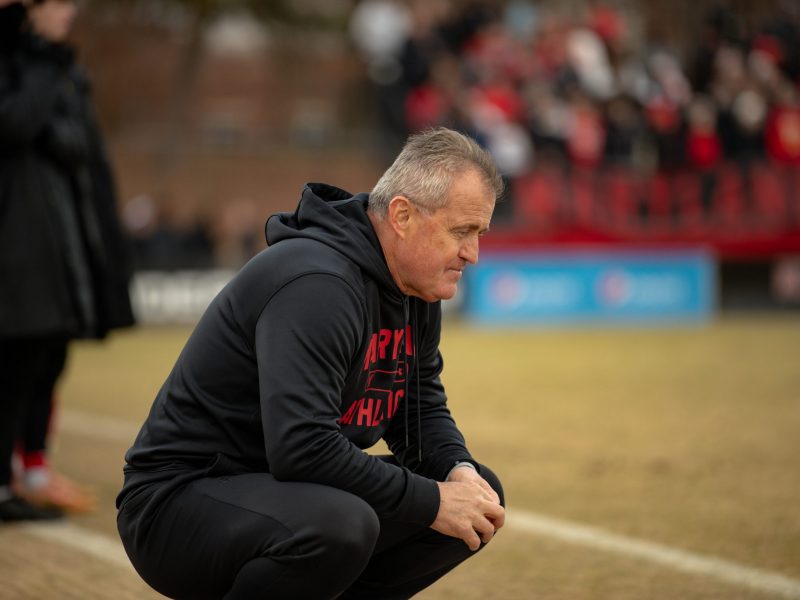Albi Ndrenika had the ball at his feet.
The SECU Stadium bleachers filled the sky behind him as onlookers watched at the Varsity Team House fields. Maryland men’s soccer was playing a preseason exhibition match before the start of the 2023 campaign.
The midfielder unleashed a curling effort on goal with his left foot. His shot bent into the top corner, one of the most pleasing goals a player can hit.
His teammates surrounded him in astonishment. They shared high fives and pats on the back and head. Ndrenika didn’t celebrate much on the field, but he finally felt back after recovering from an injury.
The good feeling didn’t last for long.
“I wake up and I couldn’t walk,” Ndrenika said.
Ndrenika got hurt for the second time in two seasons, just days before the start of his sophomore season. The injury not only kept him off the field for the entire year — it almost forced him to give up the game he loves.
The Olney native grew up about a half hour from College Park and captained his club team, Baltimore Armour. Ndrenika arrived on campus the spring before his freshman year to train with the team during the offseason.
Ndrenika suffered a sacral stress reaction in his lower back prior to his debut. The injury brought on pain every time he ran.
He missed a portion of his freshman season, but returned in time for Maryland’s run to the second round of the 2022 NCAA tournament. In the tournament, he tallied his first two goals as a Terp against Fairleigh Dickinson and Cornell.
Ndrenika traveled to Portugal for the Terps’ foreign tour in March 2023 to gear up for his sophomore year. Signs pointed toward him being an important player in Maryland’s starting 11 the following fall.
Ndrenika’s parents, Irakli Ndrenika and Migena Ndrenika, were in College Park to watch the Terps close out their set of preseason friendlies. Then, the major setback occurred.
“We didn’t believe it at the beginning, like, ‘Was it serious?’” Irakli Ndrenika said.
[Maryland women’s basketball showcases revamped roster in pair of exhibition games]
Ndrenika could barely take a step. He couldn’t lie down on his back to sleep. There were days where he had trouble putting his socks on, and others where he needed to gulp down 12 Advil pills just to bear the pain.
Multiple visits to doctors and team trainers filled the months that Ndrenika expected to be lacing up his cleats.
Ankylosing spondylitis was the first thought, based on a certain gene found in blood testing. He was referred to Dr. Bernadette Siaton, a rheumatologist at the University of Maryland School of Medicine, to receive care for what they believed to be an autoimmune disease.
Six months of treatment brought no major improvements, and there was even fear that Ndrenika may be suffering from a form of cancer. That’s when Siaton ordered a PET scan.
The inspection, used to look for inflammation by searching for areas of high metabolic activity, provided the breakthrough the Ndrenikas were longing for — he had a bone infection called osteomyelitis.
It was the biggest challenge of Ndrenika’s young career and he was in extreme pain, but he faced it head-on.
“He never got upset,” Irakli Ndrenika said. “He never said, ‘Why me?’”
There wasn’t a certainty that he would fully recover after the diagnosis. Ndrenika sat down for a difficult conversation with coach Sasho Cirovski.
They talked about a transition into a “non-playing role.” He would still be an important part of the team, which Cirovski insisted, but he wouldn’t have the opportunity to make an impact on the pitch.
That didn’t deter him.
Ndrenika started on antibiotics this past summer. Slowly, he started getting better. The pain was subsiding, and a return to the field was viable.
But while on the medication, he was shut down from all activity. He hadn’t kicked a ball for almost an entire year. Even with progress, there was no guarantee he would play his junior year.
[Inexperience, inconsistency plague Maryland football]
His first training session in July involved intervals of walking and jogging on a treadmill and bodyweight exercises. Endurance work followed, and then drills designed for speed and change of direction. The realization that Ndrenika could return to the field was apparent.
“I think we were really smart and we were really cautious,” Katelyn Engen, Maryland men’s soccer’s athletic trainer, said. “But from where he was to where he is now has been such a steep improvement, that I think we’ve had some miracles on our side.”
Fast forward to Ndrenika’s season debut in August, where he darted in behind the Detroit Mercy back line. He skipped in the air to control a floating ball, bringing it down right at his feet. He took another touch to settle the ball, then fired a low shot over the goal line.
He rolled away in celebration with his hands over his face. He then went into a knee slide and shouted a loud scream before sitting on the Ludwig Field grass. His teammates bombarded him with hugs, creating a dogpile of red jerseys in one corner of the Terps’ home.
In Ndrenika’s first competitive game in 649 days, he was back on the scoresheet. His parents watched from the stands while his brother followed it on a Big Ten Plus stream. Tears were shed in the locker room, according to Migena Ndrenika.
“My favorite moment when I watch that back is just the reaction of my teammates. I just love it so much,” Ndrenika said. “I hope I kind of rubbed off on them and showed that, just stick with it and good things will happen.”
A year prior, Ndrenika struggled to sleep and put on socks. He dealt with the confusion of receiving different diagnoses. He battled through thoughts of being replaced and never putting on cleats again.
Now, improbably, Ndrenika is back.



